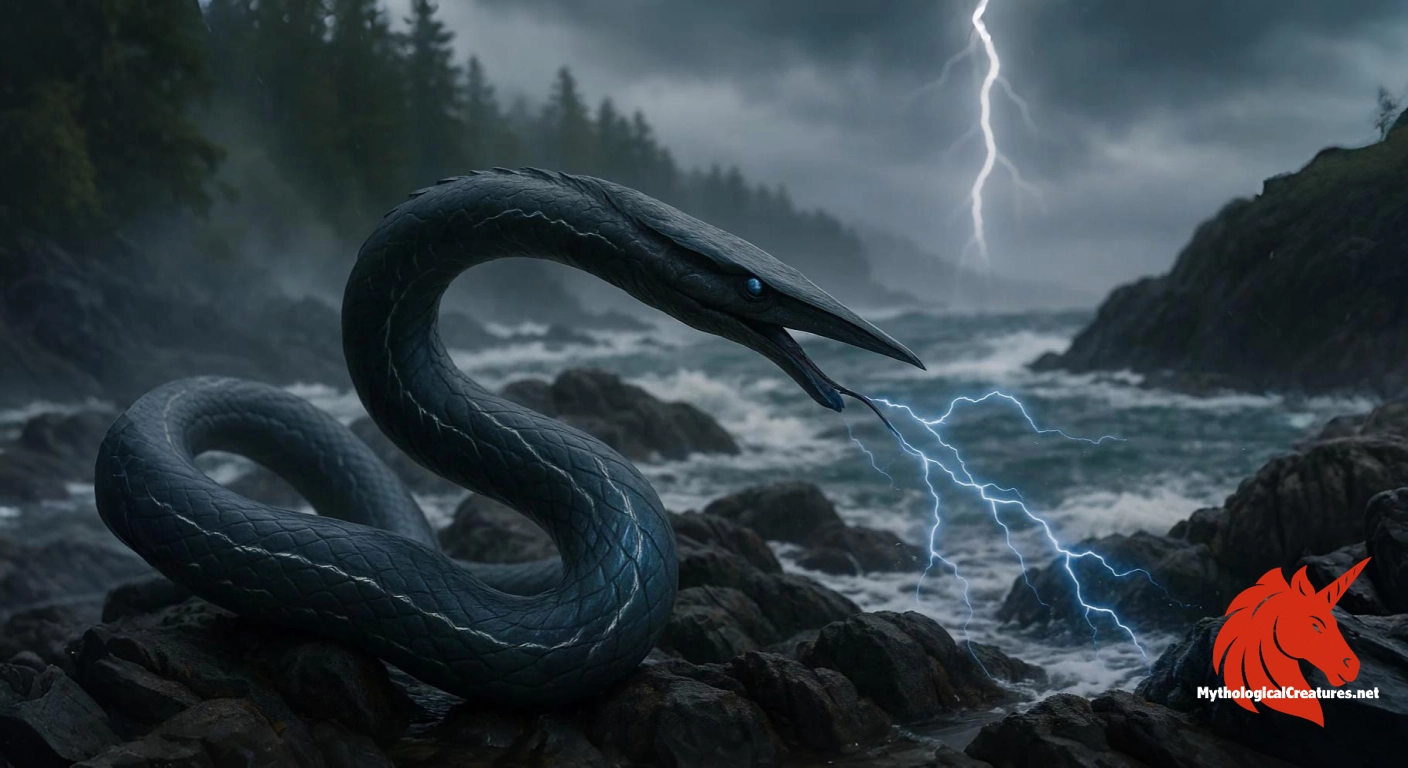Haietlik: The Haietlik is a legendary lightning serpent from Nuu-chah-nulth mythology, renowned for its association with thunderbirds and its role in whale hunts.

Haietlik
Haietlik - Embodies the union of natural forces by combining elemental lightning with a purposeful role in indigenous whale hunts
Origins & First Encounters
The Haietlik is a formidable lightning serpent that occupies a central place in the rich mythology of the Nuu-chah-nulth people on the Canadian Pacific Northwest Coast. Its very name, meaning ‘lightning serpent’, evokes both the awe of nature’s raw power and the intricate interplay between sky and water in indigenous oral traditions. Emerging from an ancient saga of cosmic balance and elemental warfare, the Haietlik is interwoven with the legends of thunderbirds and mighty whale hunts. Oral traditions recount its origins as a divine ally, entrusted with the lethal energy of storms to aid in the sustenance of the community. Its first attestations were preserved in the spirited narratives of coastal elders, who portrayed it as both a guardian and a wild force of retribution. The creature’s dual nature as both a weapon and a protector reflects the delicate equilibrium between creation and destruction. Its myth provided a framework for understanding unpredictable natural forces and the cycles of the natural world. Over time, the Haietlik has come to symbolise not only the might of lightning but also the deep spiritual connection between the people and their environment. The legend continues to resonate, providing a sense of identity and continuity for the indigenous communities that keep its tale alive.
Source Texts & Tale Variants
Indigenous oral traditions serve as the primary source for the legend of the Haietlik, with its tale passed down through generations of Nuu-chah-nulth storytellers. Early encounters with this myth were recorded by ethnographers who captured the vibrant nuances of the coastal narrative. Many versions of the story exist, each shedding a slightly different light on the creature’s attributes and its role in the natural order. Some accounts portray the Haietlik as living in the ethereal space between thunderbird feathers, while others place it in the mysterious depths of coastal waters and lakes. The narrative is enriched by a variety of regional storytellers who have adapted the tale to reflect local experiences with the elements. These variants not only diverge in detail but also emphasise different aspects of its character, such as its alliance with lightning and thunder or its connection to the marine environment. The complex tapestry of these oral sources underscores the adaptability of the myth in addressing the environmental and cultural concerns of the community. Detailed ethnographic records from different periods have helped preserve these narratives despite the challenges of translation and cultural change. Each version, while unique, contributes to a broader understanding of how the Haietlik has been revered as both a divine weapon and a potent spirit of nature.
Form & Powers
Visions of the Haietlik depict it as an immense, sinuous serpent whose very form seems to crackle with the energy of a storm. Tales describe its body as being covered in scales that shimmer with an almost metallic glint, catching the fleeting light of lightning in dazzling flashes. Its head is carved with sharp, angular features reminiscent of finely honed blades, creating an air of imminent danger and divine precision. A unique characteristic of this creature is its tongue, which is said to shoot brilliant bolts of lightning that light up the dark coastal skies. Each movement is accompanied by the crackle of electrical energy, making its presence unmistakably linked with the raw power of a storm. The Haietlik’s size is the subject of many legends, with some narratives suggesting it is large enough to rival the size of the whales it aids in hunting. Its eyes are often imagined as glowing orbs, imbued with a deep and mysterious wisdom that reflects the turbulent forces of nature. The interplay of light on its scaled body further emphasises the dual nature of its existence—both beautiful and destructive. Overall, its physical presence is a vivid manifestation of the elemental power of lightning and water, making it a truly awe-inspiring figure in myth.
Regional Faces
While the essential myth of the Haietlik remains consistent among the Nuu-chah-nulth, regional adaptations of its story reveal a fascinating range of interpretations. In some coastal communities, the creature is primarily depicted as inhabiting the realms of the thunderbird, concealed within billowing feathered expanses that herald the onset of a storm. In contrast, other groups envision the Haietlik as a resident spirit in the inland coastal waters and lakes, where its presence is intertwined with the rhythms of tidal movements and seasonal cycles. These local variations are often influenced by the specific environmental challenges and cultural practices of each community. Certain regions emphasise its role as a mediator between the land and the sky, highlighting its capacity to channel the fierce energies of a storm. In areas where the sea plays a dominant role in daily life, the Haietlik is celebrated for its direct involvement in the whale hunts orchestrated by thunderbirds. The regional narratives not only tailor its physical attributes to local landscapes but also imbue the creature with unique symbolic meanings that resonate deeply with regional experiences. Such adaptations showcase the dynamic nature of indigenous storytelling, where each rendition of the Haietlik is a mirror reflecting local ecological and spiritual realities. This diversity underscores the broader cultural importance of the myth in linking communities to the natural world.
Cultural Parallels
The legend of the Haietlik resonates with motifs found in various mythological traditions around the globe, where serpentine and lightning elements often intertwine. Similar to the way certain Mesoamerican myths celebrate the power of celestial serpents such as Quetzalcoatl, the Haietlik represents a synthesis of earthly and divine energies. Its association with the thunderbird creates a parallel to other cultural narratives in which weather deities and serpentine forms join forces to explain natural phenomena. Comparable stories from neighbouring indigenous cultures in North America also reflect an intimate connection between water, storms, and serpent imagery, underscoring a shared reverence for the primal forces of nature. The duality of being a protector and a weapon finds echoes in legends from other parts of the world, where serpents are often portrayed as both life-giving and dangerous. Despite differences in cultural context and geographical backdrop, these narratives highlight a universal human fascination with creatures that embody the chaos and beauty of nature. Such cross-cultural connections underscore the idea that natural calamities, like storms and lightning, have long been anthropomorphised as mighty and mysterious beings. In comparing the Haietlik with other mythological entities, one discovers a rich tapestry of symbolism that bridges disparate cultures through common themes of power, transformation, and survival. This comparative analysis reveals that, while the specifics of form and function may vary, the underlying human need to interpret and personify nature remains strikingly similar across traditions.
Legacy & Modern Evolution
Over the centuries, the portrayal of the Haietlik has transitioned from a strictly mythological figure into a potent symbol of natural power and cultural resilience. Early accounts, largely transmitted through oral tradition, painted it as an indispensable ally in the cosmic interplay between thunderbirds and whales. As the passage of time introduced new challenges and environmental shifts, modern storytellers and artists began to reinterpret the Haietlik to reflect contemporary concerns. Today, the creature is often featured in indigenous art, literature, and performances as an emblem of ecological strength and spiritual continuity. Its symbolism has been revitalised in modern narratives that stress the importance of respecting and preserving nature’s volatile forces. In contemporary dialogues about cultural identity and environmental stewardship, the Haietlik serves as a bridge between ancient wisdom and modern ecological awareness. Artistic representations frequently blend traditional imagery with modern techniques, creating dynamic portrayals that honour both past and present. Documentaries and cultural exhibitions continue to explore its legend, inviting new generations to discover its storied past. The enduring legacy of the Haietlik is a testament to the adaptability of myth, capable of evolving with the times while retaining its essential power and mystery.
Interesting Fact
It uniquely bridges both the aerial and aquatic worlds, reputed to dwell among thunderbird feathers as well as in coastal and lake environments, highlighting its role as a multifaceted natural force.
Quick Creature Info
Origin:
Features:
Associations:
Our Mythic Legendary Rating:

Also Sometimes Known As:
Habitat:
Supernatural Powers:
Physical Attributes:
Abilities:
Behavior:
Lore:
Related Creatures, Tales or Lore
- JJörmungandr
- QQuetzalcoatl
- RRainbow Serpent
References
Discover Another Mythical Legend You May Not Have Heard Of?
Uncover the mysteries of ancient folklore and expand your knowledge of legendary beings from cultures around the world.
Dare to Meet the Ochokochi....
Curated by the Mythological Creatures Team (rev. May 2025)
